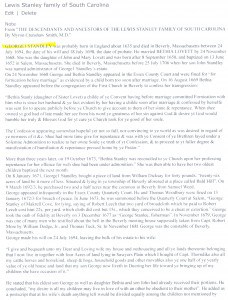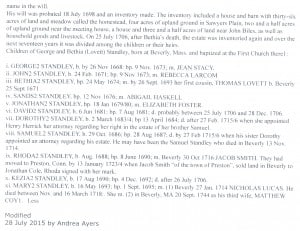George and Bethia Stanley
JONATHAN2 STANDLEY (George1) was baptized at the First Church in Beverly, Mass. 18 January 1679/80. He died probably in North Carolina after 28 February 1750 when he sold a parcel of land in Bertie County, North Carolina. About six years after his father died, Jonathan2 Standley married ELIZABETH FOSTER on 25 January 1704 at the Second Church of Boston. They were married by the Rev. Cotton Mather. She died, presumably in North Carolina, after 1 April 1713 when she signed a deed by her mark – that was the last known appearance of her name in any known document.
Two years after Jonathan Standley married Elizabeth Foster, his mother died. Following the death of Bethia Standley, a division of his father’s estate occurred on 26 July 1706. In that division “Jonathan Standley of Boston….mariner” received “twenty & five pounds curr Silver money of New England” as his share. He and his wife, Elizabeth appeared and signed the document with their marks. Signing with a mark generally suggests that one cannot write their name.
By 1707 Jonathan Standley was in Perquimans Precinct, Albemarle County, North Carolina. On 31 January 1706, as “Jonathan Stanley, Mariner”, he purchased a “plantation and tract of land containing three hundred and sixteen acres”. Six years later on 1 April 1713, Jonathan “Stanly” of Perquimans Precinct and Elizabeth his wife sold the same land. They moved to Chowan Precinct in Bertie, North Carolina and purchased more land.
There is one interesting record from the Boston Deaths 1700-1799 in which a “child of Jonathan Stanley” was buried on 8 or 12 October 1714 at Boston. Since Jonathan Standley was a mariner, it is possible that Jonathan and Elizabeth briefly returned to Boston where their child died in 1714. A search of all the early 18th century records of Boston showed no other records of any “Jonathan Stan(d)ley”.2
In any case, Jonathan moved to Chowan Precinct in Bertie, North Carolina and bought 260 acres of land on the south side of Ahotsky Swamp. Recorded at the February Court 1729. At the November Court 1733, he recorded 250 more acres in the same area. On 13 December 1748, he sold 300 acres of land for forty pounds to “George Standly son of the said Jonathan Standly”. Clearly, on 13 December 1748 Jonathan2 Stanley sold 250 acres of land to his son, George3 Stanley – the father of our Lewis4 Stanley. The county boundaries in North Carolina changed radically over the years. Today the area of Ahotsky Swamp is probably near the town of Ahoskie, Hertford Co., North Carolina.
On 28 February 1750 Jonathan Stanley, Sr., now of Johnston County, North Carolina, sold to Nathaniel Nicholas 300 acres of land on the South Side of Ahotsky Swamp in Bertie Co., N.C. This land “being the plantation whereon I lately lived” was adjacent to the land of George Stanley and Thomas Hudson. This deed was witnessed by George Stanley and William Lewis. No further records of Jonathan2 Stanley have been identified in Bertie or Johnston Counties, North Carolina. Some records of the Johnston Co., N.C. do not survive. Jonathan2 probably died in Johnston Co., N.C. sometime after 1750.
Children of Jonathan Standley and Elizabeth Foster – Elizabeth was clearly the mother of the oldest child and perhaps the mother of the others:
i. JONATHAN3 STANDLEY,
ii. ?SANDS3 STANDLEY,
iii. GEORGE3 STANDLEY (Jonathan2, George1) was born by 1727 at the latest (since his father sold him land in 1748) and died in the spring of 1784 in Wilkes Co., Georgia. He married Ann_______. His father, Jonathan2 sold him 300 acres of land on 13 Dec 1748 for 40 pounds. The land was on the south side of Ahotsky Swamp, then in Bertie Co., North Carolina and was part of the land that his father had purchased by 1729. Of interest is the fact that in 1750 Jonathan2 Standley sold part of his original plantation to Nathaniel Nicholas. This land was next to the land of George3 Standley. On 17 Sept. 1755 Nathaniel Nicholas wrote his will. Within the will was the following:
“North Carolina Bertie County September 22 Day 1755 This day came George Standley and Ann Standley Wife of the said George before me and made Oath on the holy Evangelist that on Wednesday the Seventeenth of this present September that they were at the house of Nathaniel Nicholas and he being sick, but of sound sense and memory to the best of their judgement did then and there give unto his Daughter Ann Nicholas one Negro girl…..”
Clearly, George3 and Ann Standley were probably still living on the property in September of 1755 that he had purchased from his father, Jonathan. According to most records, Lewis4 Stanley was born about 1750 so it would appear that he was probably born in Bertie Co., North Carolina and George3 Standley and Ann Foster were his parents. In 1757 George Standley was on the tax list for Bertie Co., North Carolina.7
On 11 Dec 1770 George Standley and his wife “Ader” purchased 185 acres of land from Thomas and Nancy McMurry of Tyron Co., North Carolina. They paid 140 pounds for the land on the north side of Fishing Creek and adjoining the land of the Catawba Indians – today it is not far from Pine Hill, South Carolina4. However, in 1770 the land was in Tyron County, North Carolina, but by 1771 the land had become part of South Carolina. As an aside, the local whites eventually drove the Catawba Indians off their land which was given to them by the U.S. government, but that would not be the end of the story. More than 200 years later, in the late 1980’s the Catawba Indian Nation filed suit against the State of South Carolina to reclaim their original tribal lands and their suit eventually ended up in the U.S. Supreme Court. In August 1992 the Catawba Indian Nation was paid $50,000,000 to end their land claim in South Carolina. For five years (1770 to 1775) our ancestor, George3 Standley lived next to this very contested land. Of that money $30,000,000 came from the US government and $20,000,000 from the state of South Carolina.
It is not clear if “Ader” in this deed was just another name for Ann or if this was a second wife. In any case, George and Ader Standley sold this 185 acres of land in Camden Co., South Carolina on 25 Feb. 1775 to William Walker. They sold it for 660 pounds (a very nice return on their money) and in the deed the land was situated on a branch of Fishing Creek and next to the land of the Catawba Indians5.
There was a “George Stanley” who served during the American Revolution. He was on the roster at Fort Sullivan, South Carolina from 1776-1780. Private George Stanley was in the First Regiment, South Carolina, 3rd Company in February 1780.7
A Land Bounty Warrant was issued in land court in Wilkes County, Georgia on 1 Mar 1784 to George Standley. The Warrant was executed on 16 July 1784 for 100 acres of land bounded westerly by Fishing Creek, southwardly by R. Babbitt’s land, and on other sides by vacant land.6 Apparently, George Standley died in the Spring of 1784 and the Land Warrant was issued to his widow “Ader”, and dated 13 Oct 1785. A letter of administration on probate of the George Standley estate was granted to Ader 28 May 1784 in Wilkes Co., Georgia. An Inventory of the estate was taken and presented in court 27 July 1784 and recorded on 8 Oct. 1784. The appraisers were Jacob McLendon, Jacob Babbitt, and Hugh Gilmore.8
Children of George Standley and Ann Foster;
i. LEWIS ISHAM4 STANLEY, born about 1750 in Bertie Co., N.C.
ii. EZEKIEL4 STANLEY, born about 1755, probably in Bertie Co., N.C. Died in 1835 in Covington, Newton Co., GA; m. (1) Albina Wilkinson: m (2) Elizabeth Rutledge, 10 June 1813 in Clarke Co., GA

